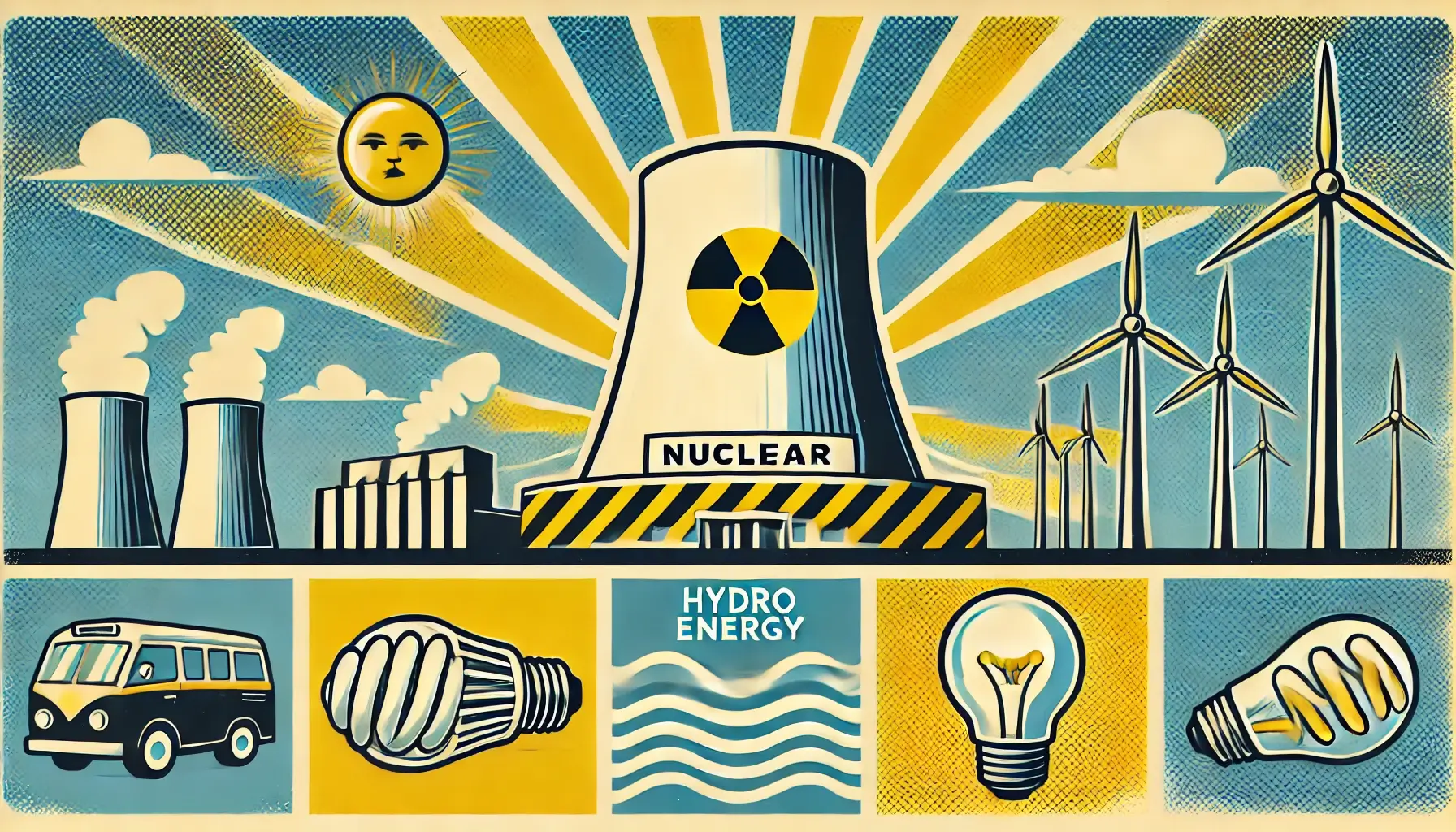The Rhetorical Crisis of Green Energy & Climate Terminology

There is a rhetorical crisis of green energy that stands in the way of real progress. The terms we use to discuss energy and environmental issues—like “green energy,” “climate change,” and “global warming”—are riddled with flaws. These phrases are vague, misleading, and often oversimplified for convenience, obscuring the true complexities of our planet’s environmental challenges. If we want to make meaningful progress, we must rethink not just our solutions but also the language and frameworks we use to describe them.
The Misleading Nature of “Green” Energy
The term “green energy” is widely used to market renewables and “clean” technologies, but it is fundamentally flawed.
“Green” Is Poorly Defined
“Green energy” lumps together vastly different technologies—solar, wind, hydro, nuclear, and even natural gas—despite their dramatically different impacts on the environment. The term implies a universal benefit to the Earth while obscuring the environmental and ethical trade-offs of these energy sources.
“Green” Implies a Land-Based Focus
The term evokes terrestrial ecosystems—trees, plants, and forests—but ignores the critical role of water ecosystems, where much of the damage from human activity occurs. Oceans, lakes, and rivers are vital to regulating the planet’s climate, yet they are disproportionately harmed by pollution, acidification, and industrial runoff.
Reframing the “Colors” of Energy
To address this confusion, energy sources should be classified by colors that reflect their physical properties, production processes, or environmental impacts. This approach provides a clearer and more descriptive framework:
- Green Energy: Solar and wood-burning.
- Solar: The sun, scientifically classified as a “green star,” is the direct source of this energy.
- Wood-Burning: Trees, which are literally green, make this a natural association. However, wood-burning emits carbon, so its inclusion as “green” energy must be qualified.
- Blue Energy: Hydro, tidal, and wave power.
- These sources depend on water, highlighting the overlooked damage to aquatic ecosystems and their vital role in climate regulation.
- Black Energy: Oil and coal.
- Fossil fuels are physically black and represent the “dirty” side of energy production.
- Gray Energy: Natural gas.
- Cleaner than coal and oil but still a fossil fuel, natural gas occupies a middle ground. “Gray” reflects this ambiguity.
- Yellow Energy: Nuclear.
- Uranium, the primary fuel for nuclear power, is processed into “yellowcake.” Yellow also symbolizes caution, reflecting the risks of radioactive waste and mining.
- Clear or White Energy: Wind power.
- Wind energy produces no visible emissions and harnesses an invisible resource—air. White or clear energy reflects its minimal operational footprint.
- Red or Orange Energy: Geothermal.
- These colors evoke magma and the heat harnessed from the Earth’s core.
This revised framework creates a more intuitive and honest way to understand energy sources, moving beyond the oversimplified and misleading “green” label.
The Flaws of Climate Rhetoric
Just as “green energy” lacks precision, the phrases “climate change” and “global warming” fail to capture the full scope of what’s happening to the planet.
“Climate Change” Is Too Broad
The climate has always changed throughout Earth’s history, from ice ages to warming periods caused by volcanic eruptions. Without specifying the causes—such as anthropogenic CO₂ emissions, deforestation, or oceanic destabilization—the term becomes meaningless.
“Global Warming” Is Too Narrow
While global temperatures are rising overall, some regions experience cooling, extreme weather, or erratic patterns. “Warming” fails to encompass these complex and uneven effects.
Reframing the Conversation
Instead of vague terms, we need scientifically precise language:
- “Carbon Imbalance”: Highlights the excess greenhouse gases in the atmosphere.
- “Ecosystem Disruption”: Captures the broader impact on land, water, and biodiversity.
- “Planetary Heat Retention”: Describes the greenhouse effect driving temperature changes.
- “Oceanic Destabilization”: Points to the oceans’ critical role in absorbing heat and carbon.
These terms may not be politically convenient, but they demand a higher level of discourse and understanding, weeding out oversimplified narratives.
The Production Problem of “Clean” Energy
The production of so-called “clean” energy technologies often creates significant environmental and ethical issues, revealing that many of these solutions are not as “clean” as marketed:
- Electric Vehicles (EVs):
- Mining for lithium, cobalt, and other materials devastates ecosystems and exploits labor, often in nations with poor environmental protections.
- While EVs reduce emissions during use, their production and battery disposal often result in a net negative impact on the environment.
- Solar Panels:
- Their manufacturing involves toxic chemicals and significant energy inputs. Old panels also create e-waste that’s difficult to recycle.
- Wind Turbines:
- While efficient during operation, their massive blades are often non-recyclable, ending up in landfills and creating long-term waste issues.
- LED Lighting:
- Despite being marketed as “green,” LED bulbs have flaws:
- Production: LEDs rely on rare earth metals, which are energy-intensive to mine and process.
- Quality of Light: LEDs often fail to match the natural, broad-spectrum light of alternatives.
- Recycling: Unlike traditional bulbs, LEDs are difficult to recycle, contributing to e-waste.
- Better Alternatives Exist: As a former lighting salesman, I saw that induction lighting was often a superior solution for parking lots and streetlights. Induction lighting:
- Offers cheaper installation and maintenance costs.
- Lasts longer than LEDs.
- Provides better energy efficiency in many cases.
- Despite being marketed as “green,” LED bulbs have flaws:
The Way Forward Requires Clarity, Not Just Cleanliness
1. Demand Precision in Rhetoric
Environmental discussions must embrace specificity. Terms like “climate change” and “green energy” need to give way to language that captures the real challenges and trade-offs involved.
2. Reassess “Clean” Energy
Recognize and address the hidden costs of “clean” technologies. Focus on innovations that minimize their environmental impact across the entire lifecycle.
3. Focus on the Oceans
Shift from a “green” narrative to a “blue” one, emphasizing the oceans’ central role in regulating climate and absorbing human impacts. Protecting marine ecosystems is as vital as preserving forests.
4. Promote Alternative Technologies
Explore and invest in less-publicized solutions, such as induction lighting, which can outperform heavily marketed technologies like LEDs in specific applications.
5. Educate for Understanding
Elevate the public discourse by prioritizing technical accuracy and critical thinking over marketing-friendly oversimplifications.
Get Real If You Want Real Change
The rhetoric of “green” energy and climate terminology is flawed, oversimplified, and often misleading. By rethinking our frameworks—reclassifying energy sources with more accurate color associations, demanding precision in climate discussions, and addressing the hidden costs of “clean” technologies—we can foster a more honest and productive dialogue. True sustainability isn’t about shifting the burden elsewhere; it’s about making the world better for everyone, not just those who can afford to market their solutions as “green.”
